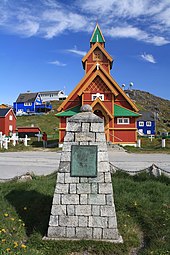Otto Fabricius (clergyman)
Otto Fabricius (born March 6, 1744 in Rudkjøbing, today Rudkøbing , † May 20, 1822 in Copenhagen ) was a Danish clergyman and one of the most important pioneers in researching the fauna and language of Greenland.
youth
Otto Fabricius (outdated Otho Fabricius ) grew up as the son of the provost Hans Fabricius and his second wife Else Cathrine Fabricius née. Ursin in a religious family home. Since the grandfather was a blacksmith, the family adopted the Latinized surname Fabricius. Strongly influenced by the mission of Hans Egedes , the apostle of Greenland , Fabricius studied from 1762 with the desire to become a missionary in Greenland. a. at the Greenlandic seminar in Copenhagen. His half-brother Christen returned from Greenland in 1764 after a five-year stay, which further sparked Otto's enthusiasm.
Greenland
In 1768 Fabricius went to Frederikshåb (Greenlandic: Paamiut ) for five years to proselytize the Inuit . The attentive observer quickly managed to familiarize himself intensively with the Greenlandic language and culture. He lived with the Greenlanders their way of life. The results of his linguistic studies are a Greenlandic grammar (1791) and the Greenlandic dictionary (1804). They built on the work of Paul Egedes , with whom he had a lifelong friendship. Fabricius also translated the New Testament (1794 and 1799) into Greenlandic for missionary purposes. His translation of Genesis appeared posthumously .
Fabricius as a scientist
His main zoological work Fauna groenlandica (1780) is also connected to Greenland . In it, Fabricius described the Greenlandic fauna scientifically and with astonishing powers of observation, following the example of Carl von Linné : 468 animal species - in the way of thinking of the time, starting with humans, the Eskimo , down to the sea sponges . Among them were about 100 previously unknown species. To this day, it is the basic work of the Greenland fauna. In the scientific system his name is abbreviated as O. Fabr . Each animal species is shown next to its description on a copper engraving. Even after the work was published, Fabricius continued with further zoological treatises, including a. on the food of whales (1781), on the arctic fox (1788) and on seals (1790/91), attracted attention. However, Fabricius was no longer able to achieve his goal of a physical and ethnological overall representation of Greenland.
Return to Denmark
After his return to Denmark in 1773, Fabricius was pastor in various places in Norway and Denmark. In 1774 he married the Norwegian Anna Dorothea Ziege (died 1785). In 1783 they both moved to the Danish capital, where Fabricius taught Greenlandic and worked as a clergyman in various parishes. In 1786 he married his second wife Anna Gunilde Heineth (d. 1834) and left numerous descendants. Most recently, Fabricius was highly respected at the Church of the Redeemer in Copenhagen with the title and rank of bishop and professor of theology.
Most important writings
- Fauna Groenlandica, systematice sistens animalia Groenlandiæ occidentalis hactenus indagata, qvoad nomen specificum, triviale, vernaculumqve; synonyma auctorum plurium, descriptionem, locum, victum, generationem, mores, usum, capturamqve singuli, prout detegendi occasio fuit, maximaque parte secundum proprias observationes - Hafn .; Lips., 1780.
- Bidrag til Bible Kundskab ved oplysende Anmærkninger over vigtige og vanskelige Steder i den hellige Skrift - Copenhagen, 1783–1787.
- Fem Taler, til Erindring af den Kongelige Stiftelse for fader- og moderløse Børn, holdne i Waysenhuus-Kirken i Aarene 1783 to 1787 - Copenhagen, 1787.
- Forsøg til en forbedret grønlandsk Grammatica - Copenhagen, 1791 (2nd edition Copenhagen, 1801).
- Den grønlandske Ordbog - Copenhagen, 1804.
- Grønlandsbeskrivelse Edited by A. Ostermann - Copenhagen, 1946 (= Meddelelser om Grønland Volume 129, No. 4).
literature
- A. Jantsen: Fabricius, Otto . In: Carl Frederik Bricka (Ed.): Dansk biografisk Lexikon. Tillige omfattende Norge for Tidsrummet 1537-1814. 1st edition. tape 5 : Faaborg – Gersdorff . Gyldendalske Boghandels Forlag, Copenhagen 1891, p. 30-32 (Danish, runeberg.org ).
- Fabricius, Otto . In: Christian Blangstrup (Ed.): Salmonsens Konversationsleksikon . 2nd Edition. tape 7 : Elektriske Sporveje – Fiesole . JH Schultz Forlag, Copenhagen 1918, p. 657-658 (Danish, runeberg.org ).
| personal data | |
|---|---|
| SURNAME | Fabricius, Otto |
| ALTERNATIVE NAMES | Fabricius, Otho |
| BRIEF DESCRIPTION | Danish clergyman, zoologist and linguist |
| DATE OF BIRTH | March 6, 1744 |
| PLACE OF BIRTH | Rudkøbing |
| DATE OF DEATH | May 20, 1822 |
| Place of death | Copenhagen |

